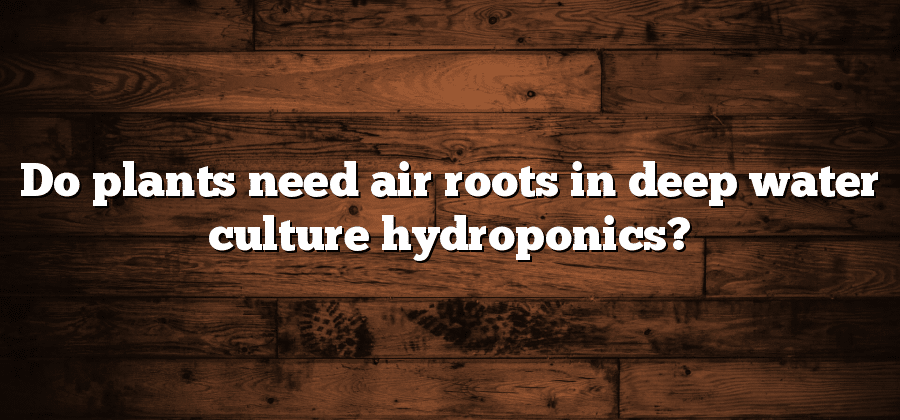Overview of Deep Water Culture Hydroponics
Deep Water Culture (DWC) hydroponics is a popular and highly effective method of growing plants without soil. In this system, the plant roots are suspended in a nutrient-rich solution, allowing for maximum nutrient uptake and optimal growth. DWC hydroponics is based on the principle of keeping the roots consistently submerged in oxygenated water, providing the plants with the essential elements they need to thrive.
One key advantage of DWC hydroponics is its simplicity and ease of set up. It requires only a few basic components, including an air pump to ensure a constant supply of oxygen to the roots, a water reservoir, and a container to hold the plants and their growing medium. The system is relatively low maintenance and can be easily scalable, making it suitable for both hobbyists and commercial growers.
In the next sections, we will delve deeper into the intricacies of DWC hydroponics, discussing the role of air roots in plant growth, the importance of oxygen in hydroponic systems, and how DWC hydroponics works. We will also explore other types of hydroponic systems, providing a comprehensive understanding of the different options available to growers.
Understanding the Role of Air Roots in Plant Growth
The roots of a plant play a crucial role in its overall growth and development. While most people are familiar with the underground roots that absorb water and nutrients from the soil, there is another type of roots that are equally important – air roots. Air roots, also known as aerial roots, are specialized structures that grow above the ground, often branching out from the stems or branches of the plant.
One of the primary functions of air roots is to enhance the plant’s ability to access oxygen. Unlike underground roots that are surrounded by soil particles, air roots are exposed to the air. This allows them to take in the necessary oxygen directly from the atmosphere. Oxygen is essential for the survival of plant cells as it is involved in various metabolic processes, such as respiration. Air roots, therefore, ensure that the plant receives an adequate supply of oxygen, which is necessary for its growth and overall health. Additionally, air roots also provide stability to the plant by anchoring it to its support, be it a wall, tree, or any other structure. This enables the plant to grow upright and withstand external forces such as wind or heavy rain.
The Importance of Oxygen in Hydroponic Systems
Ensuring an adequate oxygen supply in hydroponic systems is crucial for healthy plant growth and optimal nutrient absorption. Unlike traditional soil-based cultivation, where plants naturally access oxygen from the atmosphere through their roots, hydroponic plants rely on the grower’s ability to provide an oxygen-rich environment. This is because plants grown hydroponically are suspended in a nutrient solution, which doesn’t contain the same levels of oxygen as soil. Without sufficient oxygen, plant roots may become deprived, leading to stunted growth, nutrient deficiencies, and even root rot. Hence, maintaining oxygen levels is paramount for successful hydroponic cultivation.
One way to introduce oxygen into a hydroponic system is through the use of air stones or diffusers. Placed at the bottom of the nutrient solution reservoir, these devices create small bubbles that rise to the surface, facilitating the exchange of gases. Oxygen from the atmosphere can then dissolve in the water, increasing the available oxygen for plant roots. Another method of oxygenation is using a system known as Deep Water Culture (DWC), where plant roots are submerged directly into the nutrient solution. In this system, an air pump is used to generate bubbles, which in turn supply oxygen to the roots. These techniques ensure that plants receive the oxygen they need for photosynthesis, respiration, and nutrient uptake, ultimately promoting robust growth and higher yields in hydroponic systems.
How Deep Water Culture Hydroponics Works
Deep Water Culture (DWC) hydroponics is a popular method of soilless gardening that allows plants to thrive in a nutrient-rich water solution. This technique works by suspending the plant’s roots directly in the water, promoting rapid growth and maximum nutrient absorption. The system typically includes a reservoir, an air pump, and a floating platform, creating an optimal environment for plant development.
In a DWC system, the plant’s roots are constantly submerged in the nutrient solution and receive a continuous supply of water and oxygen. The oxygen is supplied through the use of an air pump, which releases air bubbles into the water, creating a constant stream of oxygen for the roots to absorb. This abundant oxygen supply stimulates root development, enhancing nutrient uptake and promoting healthy plant growth.
Overall, the DWC hydroponic system works by providing plants with an ideal environment for nutrient absorption and growth. Its simplicity and effectiveness have made it a preferred choice among many hydroponic enthusiasts. By allowing the roots to flourish in a highly oxygenated water solution, DWC hydroponics ensures that plants receive the necessary elements for vigorous and healthy development.
Exploring the Different Types of Hydroponic Systems
One of the most widely used hydroponic systems is the nutrient film technique (NFT). In this system, a thin film of nutrient solution continuously flows over the plant roots, providing them with a constant supply of water and nutrients. This method is highly efficient as it minimizes water and nutrient consumption, making it ideal for commercial hydroponic operations.
Another popular hydroponic system is the ebb and flow, or flood and drain, system. This system involves periodically flooding the plant roots with nutrient solution and then draining it away. This cycle ensures that the plants receive a sufficient amount of water and nutrients without becoming waterlogged. The ebb and flow system is versatile and can be used for a wide range of plant sizes and types. It is commonly used in home hydroponics and smaller-scale commercial setups.






